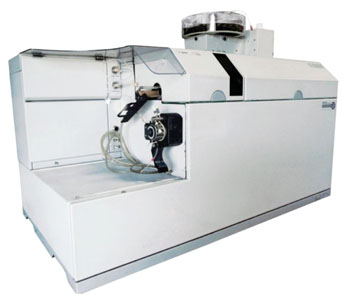Robust Method Determines Serum Chromium and Cobalt
By LabMedica International staff writers
Posted on 29 Jan 2015
Chromium (Cr) and cobalt (Co) metal ions released from orthopedic prostheses, such as metal-on-metal (MoM) bearings, may be related to wear of the bearing surface and these ions may serve as indicators of the in vivo performance of MoM bearing surfaces.Posted on 29 Jan 2015
A simple and sensitive assay has been developed which is suitable for the simultaneous measurement of serum Cr and Co using inductively coupled plasma-mass spectrometry (ICP-MS) which can be used in clinical routine laboratory practice.

Image: The octopole reaction inductively coupled plasma-mass spectrometer system 7500CE ORS-ICP-MS (Photo courtesy of Agilent Technologies).
Scientists at the Sungkyunkwan University School of Medicine (Seoul, Republic of Korea; www.skkusm.ac.kr) evaluated the clinical usefulness of the assay, in 51 healthy subjects and 74 patients with MoM prosthesis. They collected 185 serum samples from 74 hip resurfacing arthroplasty (HRA) patients including 10 preoperative samples. The assay was validated by evaluating its accuracy, intra- and inter-assay precision, low limit of quantification (LOQ), limit of detection (LOD), and linearity range.
Analyses were performed by inductively coupled plasma-mass spectrometry on a 7500CE ORS-ICP-MS (Agilent Technologies; Santa Clara, CA, USA; www.agilent.com). For reference interval verification of serum Cr and Co levels, 51 healthy subjects were selected among people who had no history of occupational exposure or iatrogenic exposure to metallic implants, such as prostheses, surgical screws, or intrauterine devices.
The serum Cr and Co concentrations were 0.60 ± 0.12 μg/L and 0.29 ± 0.15 μg/L in 51 healthy subjects. In 74 patients (185 serum samples) after HRA with a median duration implanted of 48 months (range, 1 to 138 months), the median concentrations of Cr and Co were 2.75 μg/L (range, 0.61 to 116.8 μg/L) and 1.49 μg/L (range, 0.12 to 127.8 μg/L), respectively. Three patients out of 74 patients showed greater than 20 μg/L of serum Cr and Co levels during postoperative monitoring. Cr and Co levels in seven patient groups receiving HRA were significantly higher without regard to duration of implanted MoM than the levels in the healthy control group.
The author concluded that the simple and robust assay developed for the simultaneous measurement of serum Cr and Co using ICP-MS is easily available in routine clinical laboratory practice. This assay showed good analytical performance including precision, accuracy, linearity and LOQ. It was also assessed using large scale of 236 clinical samples from healthy subjects and patients receiving HRA. This simple assay is good enough to evaluate the nutritional status of Cr and Co in healthy people as well as monitor the performance of orthopedic prosthesis after HRA in routine clinical laboratory practice. The study was published January 15, 2015, in the journal Clinica Chimica Acta.
Related Links:
Sungkyunkwan University School of Medicine
Agilent Technologies













